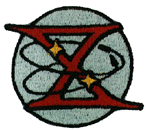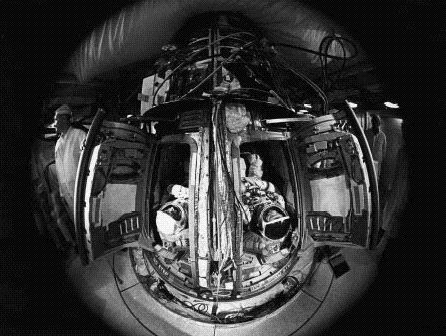
|

|
This page last updated |

|

|
This page last updated |

Gemini 10
GTA-10
July 18-21, 1966
1 2 3 4 5 6 7 8 9 10 11 12 13 14 15 Links 
Gemini X topples records, achieves basic flight goals
Johnson Space Center Space News Roundup - August 15, 1997
Reprinted from July 22, 1966 Space News Roundup.The faultless countdown of Gemini X and its Agena rendezvous vehicle to on-time liftoffs seemed to have set a trend for the rest of the mission. Except for crew eye irritation from an as yet unexplained toxic substance in the spacecraft suit circuit which cut short the standup extravehicular activity and a low quantity of attitude control fuel which caused umbilical extravehicular activity to be shortened by several minutes, the Gemini X mission was completed according to plan. At Roundup press time, Gemini X was scheduled for retrofire at 2:31 p.m. CST yesterday for landing some 34 minutes later in Area 441 in the West Atlantic. Among Gemini X’s accomplishments was a dual rendezvous with two Agena rendezvous vehicles using the primary propulsion system of the first vehicle after docking to set up the orbital conditions for rendezvousing with the second vehicle. The combined maneuvering of Gemini/Agena X was the first time in spaceflight history that a manned spacecraft has accomplished orbital maneuvering through power supplied by a second vehicle, setting thereby a new manned spaceflight altitude record of 413 nm. Gemini X is also the first mission to have two periods of extravehicular activity. Pilot Michael Collins twice opened the hatch to the hard vacuum of space to further explore manned operations outside the spacecraft and to conduct experiments.
Exact Timing
Liftoff of Gemini X was precisely on time at 4:20:26 CST to place the spacecraft in the proper phasing with the Agena X which had been launched at 2:39:44 CST and in proper relation to Agena VIII. Both launches were nominal and the systems aboard both spacecraft functioned smoothly throughout the mission. Cutoff velocity was 25,711 feet per second and an adjustment spacecraft thruster burn of 27 feet per second was added after insertion. A series of maneuvers by the crew of Gemini X placed the spacecraft within visual contact of Agena X by 4 hrs 6 min after liftoff and docked with the Agena at about 5 hrs 50 min after liftoff over the Pacific Southwest of Hawaii. Gemini X’s thruster fuel remaining after the rendezvous maneuvers was some 380 pounds instead of the premission estimate of 680 pounds, and flight controllers in Mission Control Center Houston immediately began shuffling experiments to optimize usage of the fuel left.
‘Really Something’
Over Hawaii at an elapsed time of 7 hrs 38 min the 16,000-pound thrust engine of Agena X’s primary propulsion system was fired to boost the combined vehicles into an orbit with an apogee of 413 nm to set a new altitude record for manned spaceflight. The earlier record was 268 nm set March 18, 1965 by USSR’s Voshkod II. That was really something, said Gemini X command pilot John Young as the burn was completed. Pretty wild, huh? replied Hawaii spacecraft communicator Ed Fendell. When that baby lights, said Young, there’s no doubt about it! Shortly after the Agena engine burn, the crew went into an eight-hour sleep period at 1 a.m. Houston time. Additional burns with the Agena’s big engine on the second day placed Gemini X in the proper phasing with the Gemini VIII Agena from which Michael Collins would retrieve a meteorite experiment package during his umbilical EVA.
Stand up EVA
Cabin depressurization and hatch opening for Collins’ standup EVA took place at an elapsed time of 23 hrs 27 min over the Canary Islands tracking station. It’s really a beautiful view out here, said Collins as he stood in his seat attached to a short tether. Body positioning has been absolutely no problem, he continued in his conversation with Houston Spacecraft Communicator C. C. Williams remoting through the Tananarive station. As a matter of fact, I sort of have to struggle to move up or down in the hatch. The suit is pressurized and fills the available space with plenty of points of suspension. Standup EVA was cut short when fumes in the spacecraft environmental control systems caused the crew’s eyes to water to the point where they could not see. Further maneuvers the next day using the Agena’s engine and the Gemini docking thrusters after the undocking brought Gemini X to within a few feet of Agena VIII and to the planned time of Collins’ umbilical EVA. Collins retrieved the micrometeoroid experiments package from Agena VIII. A low level of thruster fuel remaining caused the umbilical EVA also to be cut short before a full evaluation of the nitrogen-powered hand-held maneuvering unit could be made. Yesterday’s mission activities prior to retrofire and splashdown were centered mainly around conducting scientific and engineering experiments. A complete wrap-up of the Gemini X mission will appear in the August 5 Roundup.
Gemini X ‘Firsts’
- New manned altitude record of 413 nm. (previous record: USSR Voskhod II, 268 nm).
- First mission with two EVAs.
- First mission to use target vehicle for maneuvering thrust.
- First double rendezvous- Agena X and Agena VIII.
- First mission to achieve in one night all of the basic objectives of the Gemini program: rendezvous, docking, combined vehicle maneuvering, extravehicular activity and controlled reentry.

NASA Photo 66-H-963
Gemini X astronauts John Young, command pilot, left, and Michael Collins, pilot, right, are in the Gemini X spacecraft during the Simultaneous Launch Demonstration at the White Room Level at KSC’s Complex 19, in preparation for NASA’s Gemini X mission. The primary mission objective is successful rendezvous and docking of the Gemini 10 spacecraft with the Agena X target vehicle.

1 2 3 4 5 6 7 8 9 10 11 12 13 14 15 Links
Home Biography Missions Appearances Bibliography Site Map Critique this site!
John W. Young - American & International Hero Title Page
Page created by Dana Holland - webmaster @ johnwyoung.org
Dana's Page
This site is for informational and educational purposes only. It is NOT sanctioned by John Young, NASA, or Navarro College.